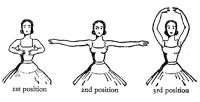 |
ROUND DANCING — CHOREOGRAPHED BALLROOMEDUCATIONAL ARTICLESMAJOR SECTIONS: Figures | Articles | Links | Alph. Index | Search | Home |
|
|
Using Your Handsby Gert-Jan & Susie Rotscheid
We have been asked at different times about styling and the use of your arms and hands, especially in the Latin dances. Please remember that styling is mostly personal preference. This is different than "correct figure execution." Correct figure execution would include, for instance, the correct placement of your feet, the correct placement of your hands and arms, the correct way to move your body, in order to dance any particular figure. Styling is what we often do to make the figure look nicer, and it also makes us feel that we dance the figure more nicely. So, a little bit about our hands when used in "open-work figures," like a New Yorker, Sliding Doors, or Hand to Hand. First, let's look at our shoulder and upper arm. When we work on an "extremity" — so, the end of something — we need to see how it all works and holds together with the rest of the body. Our hands are not separate from our arms and shoulders, but an extension of them. Remember the song that went something like, "the foot bone is connected to the ankle bone, the ankle bone is connected to the knee bone, the knee bone is connected to the thigh bone." Thinking like this will help you in your movements.Your shoulders should be down — if you are not sure if your shoulders are down, try raising them and then letting them just "drop." This is what down is. It is difficult to remember because most people, when they are concentrating, automatically raise their shoulders (this is one of the problems that causes RSI in computer workers.) Next is the elbow. The elbow should be slightly bent and NEVER behind your body, so it should be forward of your shoulders. Depending on your peripheral vision, you should just be able to see your elbows out of the corner of your eyes when looking forward. Connected to the elbow is the forearm. The forearm will be slightly upwards so that the wrist is about shoulder height. Now we finally come to the wrist and hand. The wrist should not be "broken" compared to the angle of the forearm, remember it is just an extension. However you bend your forearm your hand will "follow." If you bend your forearm up, your hand goes up, if you bend your forearm down, your hand goes down. But we're not done yet — at the end of your hand are your fingers. The fingers should be comfortably extended, including the thumb — not really stretched, but not curved. If you put (just rest) your hand on a desk — usually a comfortable position will include that your fingers are slightly spread, and they won't be completely flat against the desk. Now lift your hand keeping your fingers in the same position. Try to have you middle finger slightly lower than the other fingers. Take your middle finger and your thumb and pretend that you are holding a fairly good-sized apple with just those two fingers. This should give you a good position. For a round world, Susie & Gert-Jan— © 2003 by Gert-Jan & Susie Rotscheid
this article was published in the
|
 |
|
|
Page last revised